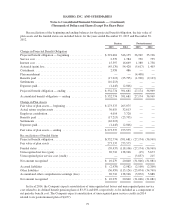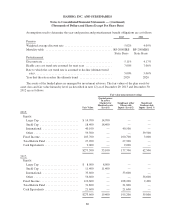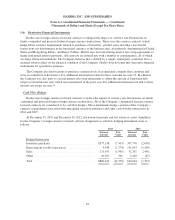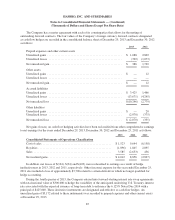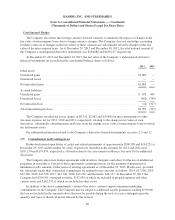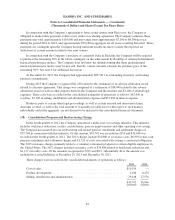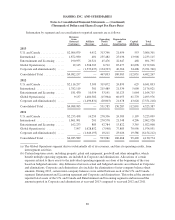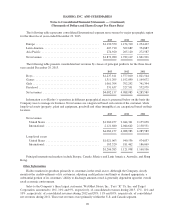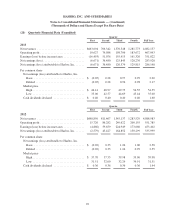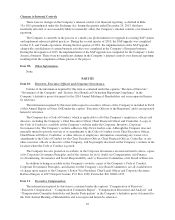Hasbro 2013 Annual Report Download - page 100
Download and view the complete annual report
Please find page 100 of the 2013 Hasbro annual report below. You can navigate through the pages in the report by either clicking on the pages listed below, or by using the keyword search tool below to find specific information within the annual report.
HASBRO, INC. AND SUBSIDIARIES
Notes to Consolidated Financial Statements — (Continued)
(Thousands of Dollars and Shares Except Per Share Data)
The following is a summary of the severance and other personnel charges related to the Company’s cost
savings initiative included in accrued liabilities:
Balance at December 30, 2012 ................................................ $34,888
2013 Charges ............................................................. 34,980
Payments ................................................................. (32,268)
Balance at December 29, 2013 ................................................ 37,600
(19) Segment Reporting
Segment and Geographic Information
Hasbro is a worldwide leader in children’s and family leisure time products and services with a broad
portfolio of brands and entertainment properties across toys, games and licensed products ranging from
traditional to high-tech and digital. The Company’s segments are (i) U.S. and Canada, (ii) International,
(iii) Entertainment and Licensing, and (iv) Global Operations.
The U.S. and Canada segment includes the marketing and selling of boys’ action figures, vehicles and
playsets, girls’ toys, electronic toys and games, plush products, preschool toys and infant products, electronic
interactive products, toy-related specialty products, traditional board games and puzzles, DVD-based games and
trading card and role-playing games within the United States and Canada. Within the International segment, the
Company markets and sells both toy and game products in markets outside of the U.S. and Canada, primarily in
the European, Asia Pacific, and Latin and South American regions. The Company’s Entertainment and Licensing
segment includes the Company’s lifestyle licensing, digital gaming, movie and television entertainment
operations. The Global Operations segment is responsible for manufacturing and sourcing finished products for
the Company’s U.S. and Canada and International segments.
Segment performance is measured at the operating profit level. Included in Corporate and eliminations are
certain corporate expenses, including substantially all costs incurred related to the 2013, 2012 and 2011 business
restructurings, the elimination of intersegment transactions and certain assets benefiting more than one segment.
Intersegment sales and transfers are reflected in management reports at amounts approximating cost. Certain
shared costs, including global development and marketing expenses and corporate administration, are allocated
to segments based upon expenses and foreign exchange rates fixed at the beginning of the year, with adjustments
to actual expenses and foreign exchange rates included in Corporate and eliminations. The accounting policies of
the segments are the same as those referenced in note 1.
Results shown for fiscal years 2013, 2012 and 2011 are not necessarily those which would be achieved if
each segment was an unaffiliated business enterprise.
88



